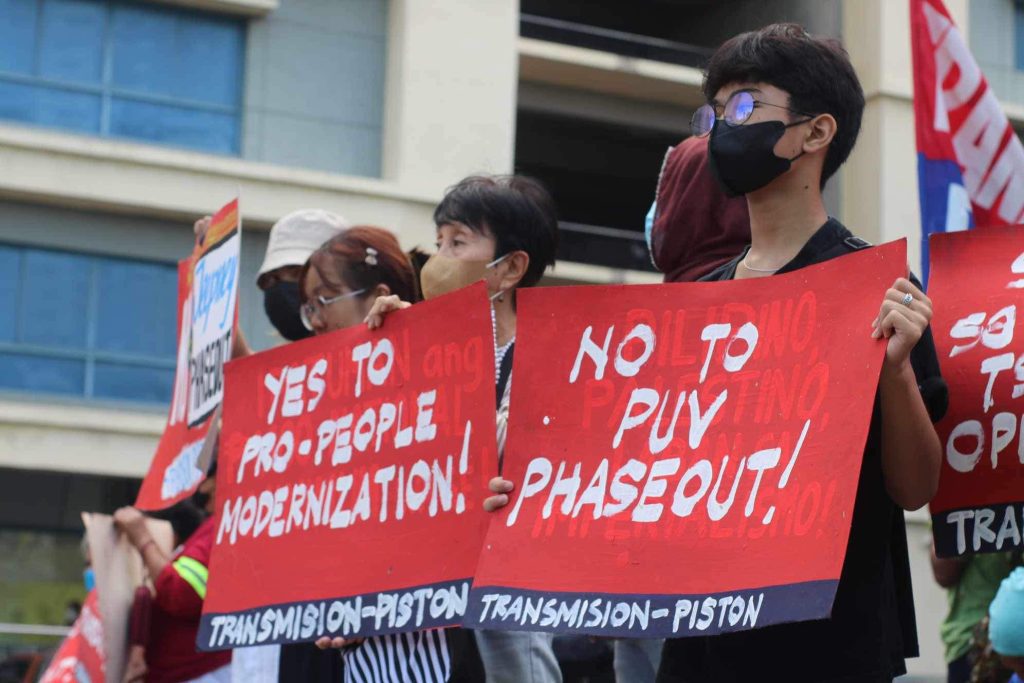
DAVAO CITY, Philippines – Wednesday’s transport strike led by Transmision-Piston paralyzed around 70 to 99% of the jeepney routes in Davao City as they oppose the impending Davao Bus System that will displace the old kings of the road.
On Friday, the Supreme Court has acted on the petition of transport group Piston and concerned commuters to prevent the Land Transportation Office and the Land Transportation Franchise Regulatory Board from implementing the December 31 deadline for consolidation of operators into cooperatives and the phaseout of jeepney franchises.
The government’s public utility vehicle modernization program (PUVMP) has met opposition from drivers and commuters. The Davao City version of this program will bring in 1,100 modern buses amounting to $1 billion from the Asian Development Bank financing under the flagship project of the government’s Build, Build, Build program of the Department of Transportation (DOTr) and Davao City LGU.
This will result in 6,000 jeepney drivers losing their source of livelihood and affect 14,000 families once the project takes place in late 2024.
Larry Argilles, spokesperson of Transmision-Piston explained in an interview that the public transport sector is “not anti-development”. But he insists that the government’s modernization plan should prioritize the drivers and operators by “rehabilitating the units” to meet the environmental standards.
With the rehabilitation of their jeeps, Piston wants the government to allow jeepney drivers and operators to continue their operation and grant them a five-year effectivity of their franchise.
City’s safety net ‘band-aid solution’
Transmision-Piston is wary of the city government’s alternatives for the jeepney drivers if it pushes through its phaseout of jeeps.
Under the plan of the DBS, there would be five social compensation packages given to drivers including educational assistance, skills training, and cash-for-work assistance.
The Department of Labor will provide a monthly cash-for-work program and provide P11,000 financial assistance.
Skills trainings will be provided by the Department of Trade and the Technical Education and Skills Development Authority (TESDA) offers various skills training for NC3-level courses for bus driving and other automotive-related courses and the four-year course education grant of P15,000 per year for four consecutive years for one beneficiary of the driver or operator under the Commission on Higher Education (CHED).
Medical assistance will be provided from PhilHealth, Lingap and Malasakit Centers.
But Argilles said this program “is only a band-aid solution” and a “one-time assistance” to the problems faced by the transport sector if they lose their livelihood.
“Dili man ni mao ang tubag sa kalisod nga kahimtang sa mga drivers ug operators. Inay usa kini ka pagpanglimbong sa unsa gyud ang among madangatan sa sunod tuig ilalom niining modernization program sa gobyerno,” Argilles said.
(That is not the answer to our problems as drivers and operators. Instead, this seems like a way of deceiving us from what will actually happen to us next year under the government’s modernization program.)
Doubtful
Jeepney drivers interviewed by Davao Today expressed doubts if they will be absorbed into the workforce through the city’s plans.
Danny, age 43, and a driver of Route 4 jeepney for 11 years said he has only finished high school and doubts if there will be companies who will give him jobs.
Another driver, Glenn Bastera, 47, doubts if he could land the job offered for both drivers and operators under the DBS as there will be thousands of drivers who will also try to apply.
“Ang dakung problema man gyud ani unsaon na ni namo sunod tuig. Maayo unta og sure nga kami tanan makatrabaho, di sab baya tanan makatrabaho anang bus,” he said.
(The biggest problem is what will happen to us next year. It would have been better if we all find jobs, but not everyone can drive a bus.)
There are 800,000 commuters in Davao City; some interviewed by Davao Today are divided about transport modernization.
Analiz Chavaiz thinks that a modernization program could give the commuting public better access to transportation.
“I think the modernized public transportation is okay like in other countries it’s very good. Transport will not have tight space, and we will be on the same level with other countries when it comes to transportation,” she said.
But for Emil John, 24, and a mall employee, modernized bus would mean additional fares that he would add to his meager budget.
“Dagdag na pud na sya sa budget if ever, imbes na magamit sya para sa food or any na kinahanglan sa balay,” he said.
(That would be an additional cost on my budget, instead of putting money for food or other needs at home.)
While the project claims that the bus system will reduce congestion and improve the public transport system, Argilles said that private cars have totaled 80% of the vehicles running around the city.
Transmision-Piston reported the routes that joined the strike include drivers and operators from Toril (70%), Matina Crossing, and Matina Aplaya (80%) from the south area of Davao City; Bunawan and Tibungco (70%), Sasa (70%) from the north; and Maa (99%) and 100% in Obrero. (davaotoday.com)
davao city, jeepney, philippines, Piston









